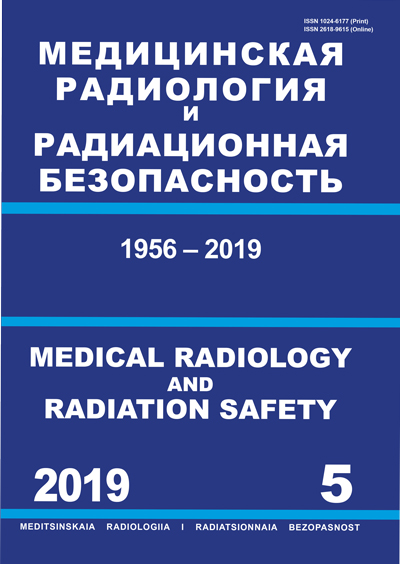GRNTI 76.03 Медико-биологические дисциплины
GRNTI 76.33 Гигиена и эпидемиология
OKSO 14.04.02 Ядерные физика и технологии
OKSO 31.06.2001 Клиническая медицина
OKSO 31.08.08 Радиология
OKSO 32.08.12 Эпидемиология
BBK 51 Социальная гигиена и организация здравоохранения. Гигиена. Эпидемиология
BBK 534 Общая диагностика
TBK 5708 Гигиена и санитария. Эпидемиология. Медицинская экология
TBK 5712 Медицинская биология. Гистология
TBK 5734 Медицинская радиология и рентгенология
TBK 6212 Радиоактивные элементы и изотопы. Радиохимия
Purpose: To determine computed tomography subtypes of amiodarone-induced pulmonary toxicity (AIPT). Material and methods: We included 214 CT exams of 110 patients with history of amiodarone use. AIPT was confirmed in 90 cases. In 81 % of patients we repeat CT exam 2–5 times, observation period till 1 month to 10 years. The mean age of patients was 71 years (21 females, 69 – males). In 52 % of patients lung scintigraphy was done. We included functional lung test, spirometry, heart ultrasound in diagnostic plan. Results: Only in 3 % of cases we detected acute form of AIPT. In 68 % of patients subacute form was revealed, in that cases we indentified different patterns of lung defeat, which mimic oncology disease, different types of interstitial pneumonias, small vessel pulmonary embolism. In other cases chronic form AIPT was suspected. Unilateral changes and craniocaudal gradient were not pathognomic for AIPT. We did not identify consolidation zones and nodules. Honeycombing was not a typical feature of chronic form of AIPT. Appearance of ground-glass opacity pattern was feature of lung toxicity exaxerbation. Conclusion: AIPT diagnose of exclusion because of it’s multiple radiological subtypes. There are no specific histological or cytological markers of the disease. Only CT could identify signs of active process and differentiate different subtypes of AIPT.
amiodarone, amiodarone-induced pulmonary toxicity, multislice computed tomography
Введение
Амиодарона гидрохлорид – препарат, относящийся к группе антиаритмических препаратов III класса по классификации E.M.V.Williams (1984), его использование началось с 1967 г. Амиодарон на настоящий момент занимает ведущие позиции в антиаритмической терапии и используется с целью купирования и профилактики угрожающих жизни пароксизмальных нарушений ритма [1]. По данным ряда исследований, в кардиологии амиодарон показывает более высокую эффективность по сравнению с другими классами антиаритмических средств (соталол, пропафенон), которая достигает 60 %. Необходимость в имплантации кардиостимулятора у пациентов, принимавших амиодарон, возникает в 2 раза реже по сравнению с группой пациентов, принимающих соталол/пропафенон [2, 3].
Пневмотоксичность амиодарона и особенности клинико-рентгенологических форм амиодарон-индуцированных поражений легких связаны с фармакодинамикой препарата, в том числе с длительным периодом полувыведения активного метаболита дезэтиламиодарона и выраженным кумулятивным действием [4]. По данным различных авторов, пневмотоксический эффект амиодарона из всех возможных токсических эффектов занимает от 11,4 до 17 %. Для сравнения токсическое действие на щитовидную железу в виде гипо- и гипертиреоза составляет 6 и 2 % соответственно, поражение печени – около 1 % [4]
1. Lyle A, Siddoway MD. Amiodarone: Guidelines for use and monitoring. Am Farm Physician. 2003. York Hospital, Pennsylvania 68:2189-96.
2. Anane C, Owusu I, Attakorah J. Monitoring amiodarone therapy in cardiac arrthythmias in the intensive care unit of a teaching hospital in Ghana. Internet J Cardiol. 2010;10(1):1-7.
3. Ward DE, Camm AJ, Spurrell R.A.J. Clinical antiarrhythmic effects of amiodarone in patients with resistant paroxysmal tadicardias. Br Heart J. 1980;44:91-5.
4. Ernawati DK, Stafford L, Hughes JD. Amiodarone-induced pulmonary toxicity. Br J Clin Pharmacol. 2008 Jul;66(1):82-7.
5. Producers: Foucher P, Camus P. http://www.pneumotox.com // Pneumotox® Website, 1997.
6. Schwaiblmair M, Behr W, Haeckel T, Märkl B, Foerg W, Berghaus T. Drug induced interstitial lung disease. Open Respir Med J. 2012;6:63-74.
7. Mankikian J, Favelle O, Guillon A, Guilleminault L, Cormier B. Initial characteristics and outcome of hospitalized patients with amiodarone pulmonary toxicity. Respir Med. 2014;108: 638-46.
8. Ilkovich MM. Interstitial and orthopedic lung diseases. Library Specialist Doctor. Geotar 2016; 560 p. (in Russian).
9. Kennedy JI, Myers JL, Plumb VJ, Fulmer JD. Amiodarone Pulmonary Toxicity: Clinical, Radiologic, and Pathologic Correlations. Arch Int Med. 1987;147:50-5.
10. Vasic N, Milenkovic B, Stevic R, Jovanovic D, Djukanovic V. Amiodarone-Induced Pulmonary Toxicity Mimicking Metastatic Lung Disease: Case Report. J Pharmacovigilance. 2014:2-4.





